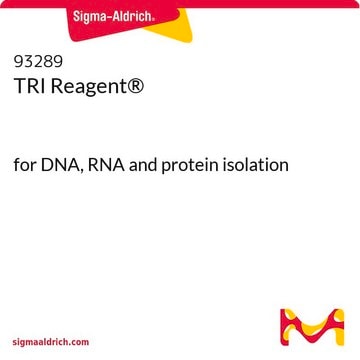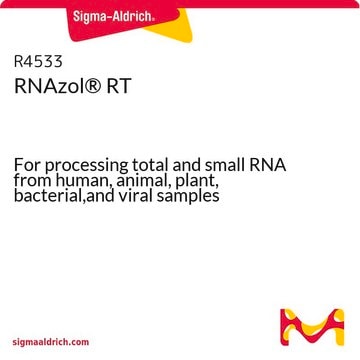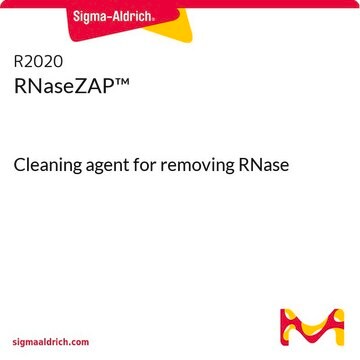This product is intended to simply maintain the integrity of the DNA and RNA during extraction and does not play a role in the disruption or digestion of the sample. Both, large and small nucleic acid molecules will be recovered. The primary factor in determining the size of the recovered nucleic acid fragments will be the method utilized to disrupt the cells or tissues.
T9424
Réactif TRI®
For processing tissues, cells cultured in monolayer or cell pellets
Synonyme(s) :
Réactif TRI® - Réactif d'isolement de l'ARN
Sélectionner une taille de conditionnement
Sélectionner une taille de conditionnement
About This Item
Produits recommandés
Niveau de qualité
Utilisation
mL sufficient for 107 cells
mL sufficient for 100 mg tissue (or)
Température de stockage
2-8°C
Vous recherchez des produits similaires ? Visite Guide de comparaison des produits
Description générale
L'homogénéisation ou la lyse de l'échantillon tissulaire dans le réactif TRI® dissout l'ARN, l'ADN et les protéines. L'ajout de chloroforme ou de 1-bromo-3-chloropropane suivi d'une centrifugation sépare le mélange en 3 phases : une phase aqueuse contenant l'ARN, une phase intermédiaire contenant l'ADN et une phase organique contenant les protéines. Chaque composant peut ensuite être isolé après séparation des phases.
Application
- isolement de l'ARN total à partir de différents échantillons de tissus et de cellules [1][2][3][4]
- lyse de monocytes [5]
- isolement de l'ARN cytoplasmique à partir de cellules Vero infectées par le SARS-CoV [6]
- isolement de l'ARN total à partir de macrophages dérivés des monocytes (MDM) infectés par le virus de la grippe A (H5N1) [7]
- préparation d'un lysat viral de culture de SARS-CoV pour la création d'un clone codant la glycoprotéine S dans le cadre de la mise au point d'un vaccin contre le SARS-CoV [8]
L'ARN, l'ADN et les protéines isolés à l'aide du réactif TRI® peuvent être utilisés dans diverses applications en aval : clonage, PCR, RT-PCR, analyses par northern blot, isolement de l'ARNm, traduction in vitro, tests de protection à la RNase, digestion par enzymes de restriction, analyses par Southern blot, SDS-PAGE ou analyses par western blot, par exemple.
Caractéristiques et avantages
Polyvalent : Le réactif TRI® donne de bons résultats sur de grandes ou de petites quantités de cellules ou de tissus ; il fonctionne avec de nombreux échantillons, notamment humains, végétaux, levuriens, bactériens et viraux.
Efficace : Le réactif TRI® donne de meilleurs rendements que les techniques au thiocyanate de guanidine/chlorure de césium classiques. L'ensemble du processus d'extraction de l'ARN de cellules ou de tissus frais peut être réalisé en moins d'une heure.
- Easily scalable RNA isolation
- Works with many sources: human, plant, yeast, bacterial, or viral
- Better yields than traditional guanidine thiocyanate/cesium chloride methods
Autres remarques
Informations légales
Produit(s) apparenté(s)
Mention d'avertissement
Danger
Mentions de danger
Classification des risques
Acute Tox. 3 Dermal - Acute Tox. 3 Inhalation - Acute Tox. 3 Oral - Aquatic Chronic 2 - Eye Dam. 1 - Muta. 2 - Skin Corr. 1B - STOT RE 2
Organes cibles
Nervous system,Kidney,Liver,Skin
Risques supp
Code de la classe de stockage
6.1A - Combustible acute toxic Cat. 1 and 2 / very toxic hazardous materials
Classe de danger pour l'eau (WGK)
WGK 2
Point d'éclair (°F)
174.2 °F - closed cup
Point d'éclair (°C)
79 °C - closed cup
Faites votre choix parmi les versions les plus récentes :
Déjà en possession de ce produit ?
Retrouvez la documentation relative aux produits que vous avez récemment achetés dans la Bibliothèque de documents.
Les clients ont également consulté
Articles
Simple DNA/RNA purification methods aid genome analysis from various sources, enhancing research efficiency.
Protocoles
TRI Reagent enables simultaneous DNA, RNA, and protein isolation with sample prep guidelines and troubleshooting.
Procedure and protocol for Anti Ago-RNA Immunoprecipitation from mammalian cells using the RIP kit
Learn Northern and Southern blotting basics, with protocols and applications for macromolecule transfer to membrane supports.
Contenu apparenté
Panorama des méthodes de lyse cellulaire et d'extraction protéique, comme la solubilisation par détergents, la lyse par congélation/décongélation, le choc osmotique, la sonication, la lyse cellulaire enzymatique et les techniques de fragmentation mécanique comme l'homogénéisation au Dounce, au Polytron ou au mortier et au pilon.
Cell lysis and protein extraction methods overview various techniques, from detergent solubilization to mechanical disruption, supporting research needs.
-
what is the size(kb) of the trizol extracted DNA?
1 answer-
Helpful?
-
-
Using trizol in isolation gDNA from nuclei (from plant). After extracting nuclei, pellet(nuclei) is dissolved in 1.6-6.4mL TE buffer and incubated with SDS and Proteinase K. Next is trizol, what is the ratio of trizol to add to this liquid sample?
1 answer-
As mentioned in the product bulletin, "the volume of the tissue should not exceed 10% of the volume of the TRI Reagent." For a sample volume range of 1.6 ml to 6.4 ml, you would need to add a minimum of 16 ml to 64 ml of Tri Reagent.
Please see the link below for more information: https://www.sigmaaldrich.com/deepweb/assets/sigmaaldrich/product/documents/294/543/t9424bulletin.pdfHelpful?
-
-
Does trizol have SDS in it?
1 answer-
As mentioned in the 'DESCRIPTION' section under 'General Description', TRI reagent® is a mixture of guanidine thiocyanate and phenol in a monophasic solution. This product does not contain SDS.
Helpful?
-
-
How long can samples be stored in TRI Reagent at -80°C?
1 answer-
Prior to phase separation, TRI Reagent-treated tissue extracts can be stored at -80 °C for years without demonstrable negative effects on
recovered RNA quality or quantity. Although salt precipitation following freezing has not been observed, the investigator must make sure that any
salts that may precipitate from the solution during the freeze-thaw cycle are resolubilized before using proceeding.See the link below to review the product datasheet, including protocols:
https://www.sigmaaldrich.com/deepweb/assets/sigmaaldrich/product/documents/294/543/t9424bulletin.pdfHelpful?
-
-
What is the Department of Transportation shipping information for this product?
1 answer-
Transportation information can be found in Section 14 of the product's (M)SDS.To access the shipping information for this material, use the link on the product detail page for the product.
Helpful?
-
-
My cells are plated on polystyrene culture plates. How do I use Product T9424, TRI Reagent in this application?
1 answer-
We recommend harvesting the cells in PBS with a rubber policeman/cell scraper, transfer to an eppendorf tube, and proceed with the RNA isolation by removing the PBS from the cell pellet and re-suspending the pellet in the Tri Reagent.
Helpful?
-
-
Which chloroform and isopropanol do you recommend to be used with T9424, Tri Reagent™?
1 answer-
For chloroform and isopropanol we recommend C2432 and I9616, respectively.
Helpful?
-
-
Can I use T9424 Tri Reagent™ for blood samples?
1 answer-
No, we recommend using T3809 Tri Reagent BD for work in blood samples.
Helpful?
-
-
If I add a volume of Product T9424, Tri Reagent™, different from 1 ml, how much chloroform and isopropanol should I add?
1 answer-
What is important is to keep the ratio the same. For example, we recommend adding 200 μL of chloroform and 500 μL of isopropanol when using 1 ml of Tri Reagent. Therefore, 100 μL of chloroform and 250 μL of isopropanol would be added if using 500 μL of Tri Reagent. Similarly, 300 μL of chloroform and 750 μL of isopropanol would be added to if using 1.5 ml of Tri Reagent.
Helpful?
-
-
What is the expiration date for Product T9424, Tri Reagent™?
1 answer-
The expiration date for T9424 has not been established. However, based on our storage guidelines, it should be usable for 1 year from the date of receipt.
Helpful?
-
Active Filters
Notre équipe de scientifiques dispose d'une expérience dans tous les secteurs de la recherche, notamment en sciences de la vie, science des matériaux, synthèse chimique, chromatographie, analyse et dans de nombreux autres domaines..
Contacter notre Service technique

















